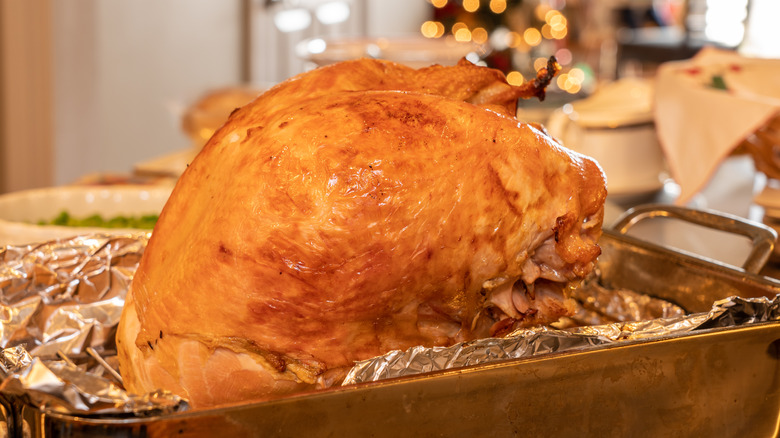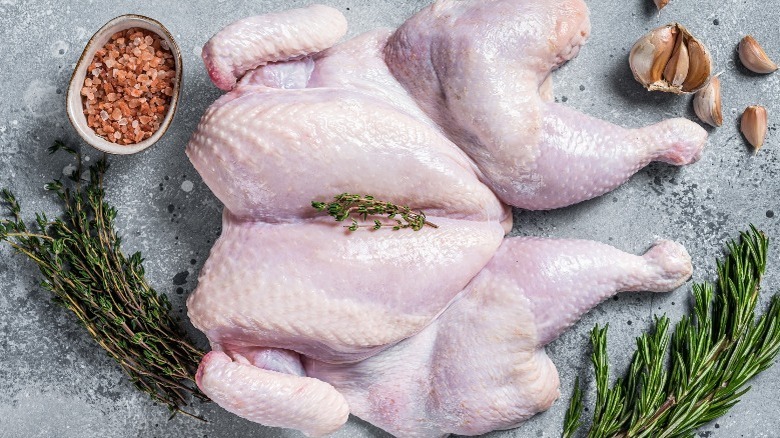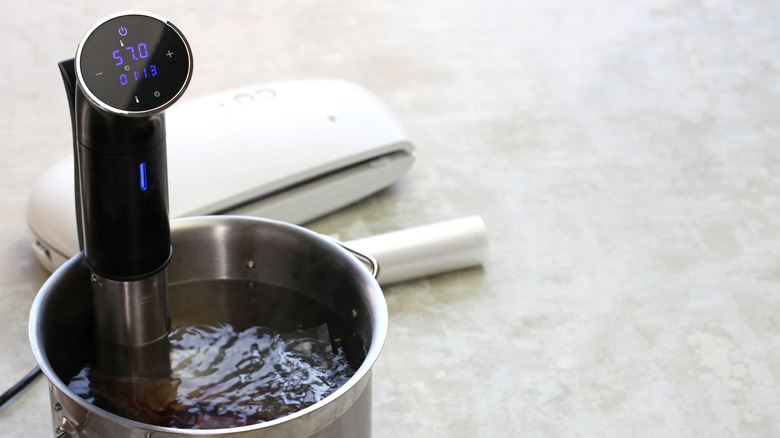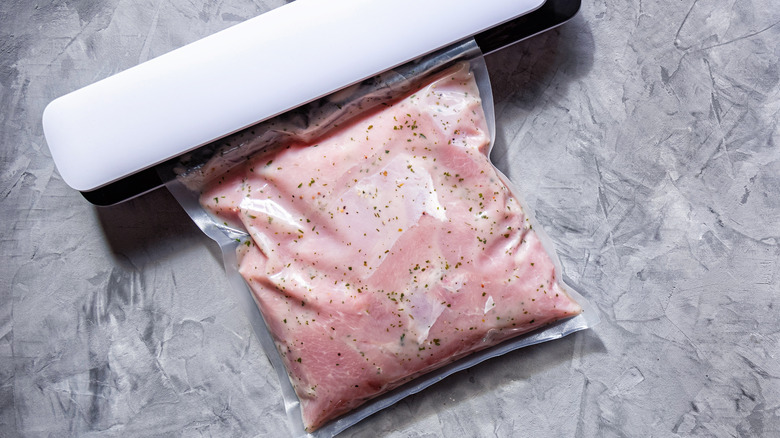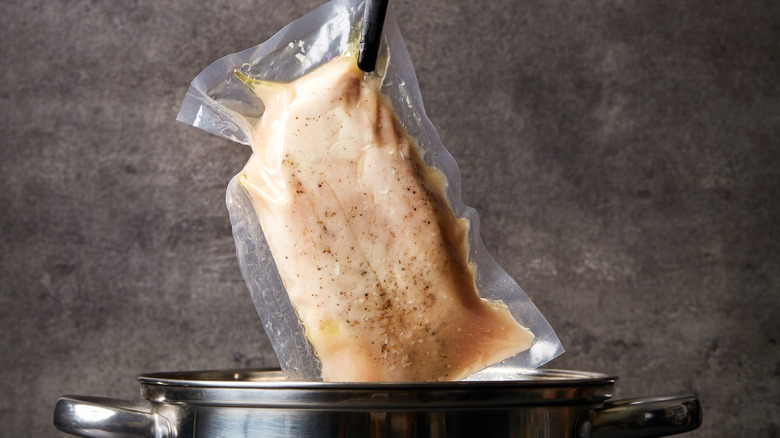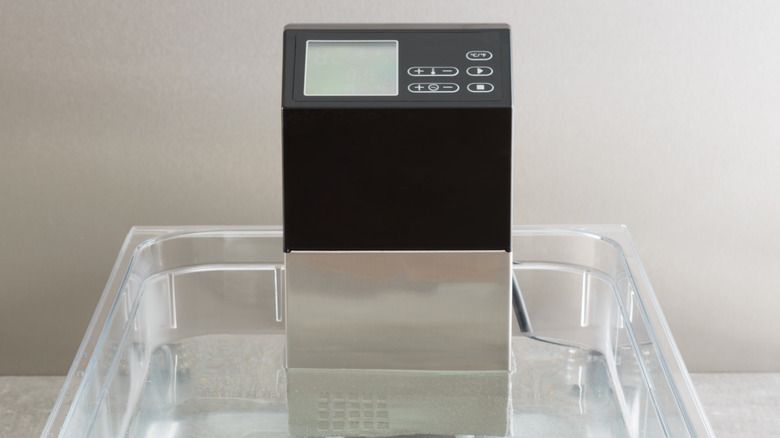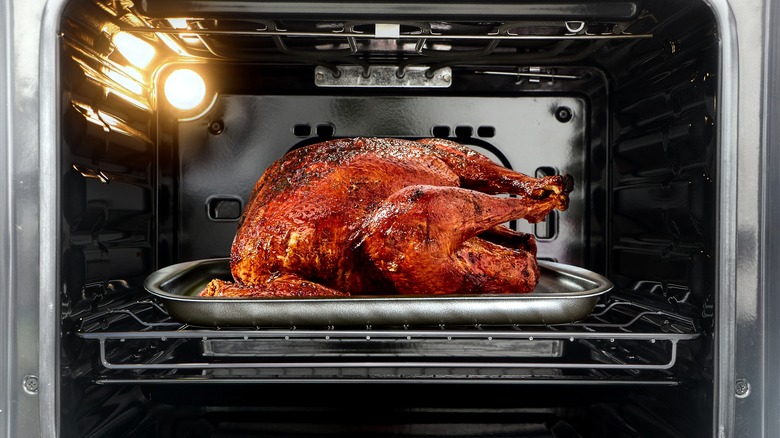Everything You Need To Know To Sous Vide Your Thanksgiving Turkey
As the holidays roll around, families unite around the table for a big meal. Thanksgiving is all about the turkey (and all the fixings, of course), and you likely have your favorite way to go about cooking it. We're all about keeping up with traditions during the holidays, but sometimes it's kind of fun to change things up in the kitchen, especially if it can take your turkey to a whole other level.
Sous vide is a great way to make the most of your Thanksgiving turkey. According to Dallas News, when you sous vide a turkey, you're cooking it in a water bath to help ensure the bird is cooked thoroughly and comes out juicy and tender. Learning how to spatchcock your whole turkey (splitting it in half and removing its backbone so it rests flat on the pan) might also help you with this cooking process. Here is everything you need to know to sous vide your Thanksgiving turkey and impress your guests.
Cut the turkey up into pieces
When you use the sous vide method to cook turkey, you'll want to start by preparing the turkey. Cutting it up into pieces (legs, thighs, breasts, and wings) is the most common approach because you can cook the various parts separately to ensure doneness. While you can cook light and dark meat together, the flavor may not be as prominent, and they require different cooking times. It's usually better to cook dark meat almost twice as long as white meat (via Sous Vide Magazine). At 145 F, thighs require about 4 hours, while breasts likely need just over 2 hours.
You don't necessarily have to break down the turkey fully. Instead of cutting the legs and the breast from the bird, you can spatchcock it. Splitting the bird in half flattens it so the meat cooks evenly in a shorter amount of time. Sous Vide Ways recommends cooking a spatchcocked turkey for 6 hours at 150 F.
If you are still feeling pulled toward the traditional look of a whole turkey on the dinner table, it's possible to sous vide a whole turkey. This is generally not recommended because it is not as precise, and the meat doesn't cook as evenly (via Wired). If that's not enough of a deterrent, you will need a huge pot for the water bath.
Cook the turkey at the right temperature
Cooking at the right temperature is essential for just about anything we make in the kitchen. No matter the method, you also want to ensure you are cooking food so it reaches a proper internal temperature. This is equally true when you're looking to sous vide your Thanksgiving turkey. According to the USDA, your turkey should be cooked to reach an internal temperature of at least 165 F. That target temperature will not only ensure that your turkey meat is tender and juicy but that it is also safe enough to eat.
Sous vide is stellar because it allows for precision cooking and lets you target the correct temperature on each piece of turkey. But you have to ensure that your sous vide machine is set to the right temperature so the meat cooks all the way through and offers the desired results.
Use a sous vide circulator
Using the sous vide cooking method produces a turkey that is cooked all the way through. With the help of a sous vide immersion circulator, you never have to worry about overcooked food. All you need to do is simply set your target water temperature and let your turkey do its thing. The internal temperature of the turkey will not get higher than what you set the circulator for since the water temperature will stay the same during the process.
According to Sous Vide Ways, when setting your sous vide immersion circulator for any poultry, the sweet spot is anywhere from 140 F to 150 F. The exact temperature depends on the desired texture and which part of the turkey you're cooking. Keep in mind that the meat's texture will change the longer it's cooked, so decide just how juicy and tender you want your turkey and plan accordingly.
Cook the turkey in sealed bags
Sous vide is French for "under vacuum." The sous vide method not only cooks your broken-up pieces of turkey in a water bath, but it does so in sealed bags. This is ideal because cooking turkey in bags will help lock in all the flavor, leaving you with juicy meat that tastes really good. You'll need to cook your turkey pieces in batches, such as the legs in one bag and then the breast in another. To make your turkey even more flavorful, add some herbs and garlic directly to the bag before sealing. However, Cook's Illustrated notes that raw garlic is unsafe to sous vide, so be sure to cook it first or use garlic powder.
If you're worried about having to buy a professional vacuum sealer to get this job done, don't stress too much. While you can certainly go all in and get a gadget like this to help streamline the cooking, you can sous vide with Ziploc bags instead. Just be sure to remove all the air in the bag before you start cooking.
Use the right water level
Since sous vide is all about using a water bath to cook your food perfectly, you need to have the proper water level to do this correctly. A common mistake in sous vide is not ensuring the food stays completely submerged. If any part of the turkey is not underwater, you take the risk that it won't cook thoroughly and adequately, and it can be unsafe to eat.
If your vacuum sealer removed all of the air, the bag should not float. However, sous vide bags are not always perfect. There are a few options to try to keep the food completely under the water for the entire cooking duration. You may need to keep it weighted down with items such as magnets or pingpong balls. But if you don't have any of those things on hand, you can also place a heavier object over the water bath. A plate may work, and Lifehacker suggests using something like a drying rack or steamer basket to ensure everything stays submerged and the meat cooks evenly.
Use a sous vide machine
When it comes to the sous vide cooking method, you don't necessarily need a machine to make it work. All you really need is a thermometer and a vessel to use for the water bath. However, if you don't want to keep a constant eye on the water temperature, investing in a sous vide machine may be a good option.
Sous vide machines come in two basic styles that manage the water differently. An immersion circulator is a wand that is placed in a separate container to heat the water, while a water oven is a covered box that heats on its own. The immersion circulator will circulate the water, but a water oven doesn't. While sous vide machines should be high-quality, they don't have to cost you the bank. Depending on your preference, you can find high-tech options with an LED touch panel and others that are more traditional.
Pop the turkey in the oven for crispy skin
Now that you know how to sous vide your Thanksgiving turkey, you might try it and be glad you did. You'll find the interior to be super juicy and cooked through perfectly. However, the skin might not be cooked the way you're used to or prefer. Since this method skips the traditional oven roasting, you won't find that extra crispy, perfectly browned turkey skin. That doesn't mean you can't get it.
To achieve that golden brown color we all know and love, all you need to do is add one extra (and very easy) step after cooking the turkey in the sous vide bath. You can simply sear the turkey in a pan to add that crispy skin if you cut it into pieces. And yet, we think it's even easier to pop the turkey in the oven for a few minutes to help it brown and come out the way you want it.
